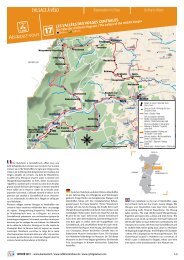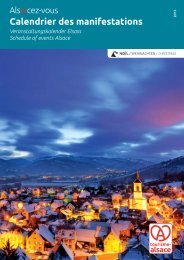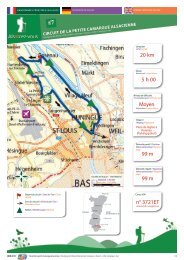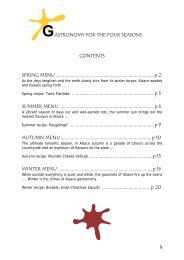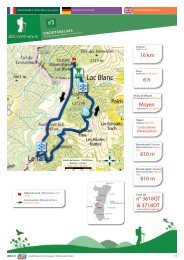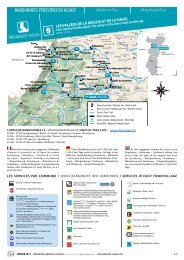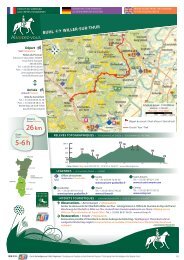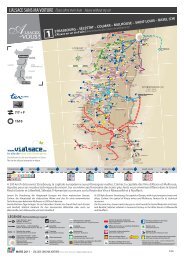Guide pratique à l'usage des organisateurs de - Tourisme Alsace
Guide pratique à l'usage des organisateurs de - Tourisme Alsace
Guide pratique à l'usage des organisateurs de - Tourisme Alsace
You also want an ePaper? Increase the reach of your titles
YUMPU automatically turns print PDFs into web optimized ePapers that Google loves.
164<br />
S<br />
C3 STRASBOURG (suite) (67000)<br />
Aubette 1928<br />
Place Kléber Tél. +33 (0)3 88 52 50 00 (réservations : 8:30 -12:30)<br />
Fax +33 (0)3 88 52 50 41<br />
www.musees.strasbourg.eu<br />
Toute l’année/ganzjährig/all year, mer. � sam./Mi � Sa./Wed. ��Sat., 14:00-18:00<br />
« Placer l’homme dans la peinture plutôt que <strong>de</strong>vant<br />
elle », affirmait Van Doesburg. C’est dans cet esprit<br />
d’avant-gar<strong>de</strong>, prônant un art total au service <strong>de</strong> la<br />
vie et <strong>de</strong> son embellissement que Theo Van Doesburg,<br />
Hans Jean Arp et Sophie Taeuber-Arp réalisent en<br />
1928 les décors du complexe <strong>de</strong> loisirs <strong>de</strong> l’Aubette.<br />
Initialement pourvue <strong>de</strong> 4 niveaux, le bâtiment voit<br />
aujourd’hui l’intégralité du premier étage restituée et<br />
classée au titre <strong><strong>de</strong>s</strong> Monuments Historiques.<br />
En empruntant l’escalier au <strong><strong>de</strong>s</strong>sin géométrique, vous<br />
pénétrerez au cœur <strong><strong>de</strong>s</strong> années folles, découvrirez le<br />
Ciné-dancing, et son décor élémentariste, le Foyerbar<br />
qui permettait <strong>de</strong> prendre un verre en suivant la<br />
projection, et l’impressionnante Salle <strong><strong>de</strong>s</strong> fêtes qui<br />
décline une stricte composition orthogonale.<br />
L’histoire <strong>de</strong> l’Aubette, <strong>de</strong> son origine <strong>à</strong> la fin du XVIII e<br />
siècle, jusqu’<strong>à</strong> l’inauguration du complexe <strong>de</strong> loisirs<br />
en 1928 y est évoquée en plusieurs points.<br />
Entrée libre.<br />
Musée <strong><strong>de</strong>s</strong> Arts Décoratifs<br />
Kunstgewerbemuseum / Museum of Decorative Arts<br />
2, place du Château Tél. +33 (0)3 88 52 50 00<br />
Tél. +33 (0)3 88 88 50 50 (réservations lun. � ven./Mo. � Fr./Mon. � Fri., 8:30 - 12:30)<br />
www.musees.strasbourg.eu<br />
Tél. +33 (0)3 88 52 28 28, Office <strong>de</strong> <strong>Tourisme</strong>/Verkehrsamt/Tourist Office<br />
lun. + mer. � ven./Mo. + Mi. � Fr./Mon. + Wed. � Fri, 12:00-18:00, sam. + dim./Sa. + So./Sat. + Sun., 10:00-18:00<br />
mar./Di./Tue., 01.01, Vendredi Saint/Karfreitag/Good Friday, 01.05, 01.11, 11.11, 25.12<br />
Installé au rez-<strong>de</strong>-chaussée du Palais Rohan, ancienne<br />
rési<strong>de</strong>nce <strong><strong>de</strong>s</strong> princes-évêques élevée <strong>de</strong> 1732 <strong>à</strong><br />
1742 par Robert <strong>de</strong> Cotte, Premier architecte du<br />
roi, ce musée comprend <strong>de</strong>ux sections: les somptueux<br />
appartements <strong><strong>de</strong>s</strong> cardinaux <strong>de</strong> Rohan d‘une<br />
part et les collections d‘arts décoratifs strasbourgeois<br />
couvrant la pério<strong>de</strong> allant <strong>de</strong> 1681 au milieu du XIX e<br />
siècle d‘autre part ( céramique Hannong <strong>de</strong> renommée<br />
internationale, mobilier, sculpture et peinture,<br />
horlogerie, ferronnerie et orfèvrerie).<br />
Le musée présente également une sélection <strong>de</strong> jouets<br />
mécaniques <strong>de</strong> la fondation Tomi Ungerer.<br />
Visites guidées pour groupes: réservation obligatoire<br />
au +33 (0)3 88 88 50 50.<br />
Prix <strong>de</strong> groupe par personne (<strong>à</strong> partir <strong>de</strong><br />
25 personnes): 3�. - <strong>de</strong> 18 ans: gratuit.<br />
Entrée gratuite du musée: le 1 er dim. du mois.<br />
Den Menschen in die Malerei zu stellen anstatt davor,<br />
lautete eine wichtige For<strong>de</strong>rung Theo van Doesburgs.<br />
In diesem avantgardistischen Geist, <strong>de</strong>r nach <strong>de</strong>m<br />
Gesamtkunstwerk im Dienste <strong><strong>de</strong>s</strong> Lebens und seiner<br />
Verschönerung strebte, schufen Theo van Doesburg,<br />
Hans Jean Arp und Sophie Taeuber-Arp 1928 das<br />
Dekor <strong><strong>de</strong>s</strong> Vergnügungskomplexes Aubette.<br />
Die drei Künstler gestalteten vier Stockwerke <strong><strong>de</strong>s</strong><br />
Gebäu<strong><strong>de</strong>s</strong>. Heute ist die gesamte erste Etage restauriert<br />
und steht unter Denkmalschutz.<br />
Über <strong>de</strong>n von geometrischen Formen beherrschten<br />
Treppenaufgang gelangt <strong>de</strong>r Besucher in <strong>de</strong>n ersten<br />
Stock <strong>de</strong>r Aubette. Hier schlug das Herz <strong>de</strong>r Gol<strong>de</strong>nen<br />
Zwanziger Jahre: <strong>de</strong>r nach elementaristischen Grundsätzen<br />
<strong>de</strong>korierte Ciné-Dancing; <strong>de</strong>r Foyer-Bar, wo<br />
man die Filmvorführungen mit einem Glas in <strong>de</strong>r<br />
Hand verfolgen konnte, und <strong>de</strong>r eindrucksvolle Festsaal<br />
mit seiner streng rechtwinkligen Komposition.<br />
Informationspulte und Tafeln geben Auskunft über die<br />
Geschichte <strong>de</strong>r Aubette von <strong>de</strong>r Errichtung <strong><strong>de</strong>s</strong> Gebäu<strong><strong>de</strong>s</strong><br />
En<strong>de</strong> <strong><strong>de</strong>s</strong> 18. Jahrhun<strong>de</strong>rts bis zur Einweihung <strong><strong>de</strong>s</strong><br />
Vergnügungskomplexes im Jahr 1928.<br />
Eintritt frei.<br />
Das Kunstgewerbemuseum befin<strong>de</strong>t sich im Erdgeschoss<br />
<strong><strong>de</strong>s</strong> Rohan-Schlosses, <strong>de</strong>r früheren Resi<strong>de</strong>nz<br />
<strong>de</strong>r Straßburger Fürstbischöfe, die zwischen 1732<br />
und 1742 vom Ersten Hofbaumeister Robert <strong>de</strong><br />
Cotte errichtet wur<strong>de</strong>. Das Museum umfasst zwei<br />
Abschnitte: die prunkvollen Gemächer <strong>de</strong>r Rohan-<br />
Kardinäle und die von 1681 bis in die Mitte <strong><strong>de</strong>s</strong><br />
19.Jh. reichen<strong>de</strong> Kunstgewerbesammlung (Hannong-<br />
Fayencen von internationalem Ruf, Möbel, Skulpturen<br />
und Gemäl<strong>de</strong>, Uhrmacherkunst, schmie<strong>de</strong>eiserne<br />
und Goldschmie<strong>de</strong>arbeiten).<br />
Außer<strong>de</strong>m zeigt das Museum eine Auswahl <strong><strong>de</strong>s</strong><br />
mechanischen Spielzeugs aus <strong>de</strong>r Tomi-Ungerer-<br />
Stiftung.<br />
Gruppenführungen: Voranmeldung erfor<strong>de</strong>rlich<br />
(Tel. +33 (0)3 88 88 50 50).<br />
Gruppenpreis pro Person (ab 25 Personen): 3�.<br />
Unter 18 Jahre: kostenlos.<br />
Kostenlosen Eintritt zum Museum: 1. So. <strong><strong>de</strong>s</strong><br />
Monats.<br />
“Put the man in the painting rather than in front<br />
of it”, said Van Doesburg. Following in this spirit<br />
of avant-gardism, advocating total art in service<br />
of life and its beautification, Theo Van Doesburg,<br />
Hans Jean Arp and Sophie Taeuber-Arp created<br />
the décor for the leisure complex the Aubette in<br />
1928.<br />
Initially <strong><strong>de</strong>s</strong>igned to span 4 levels, the first floor<br />
has now been entirely restored and classified as a<br />
historical building.<br />
Its geometrically <strong><strong>de</strong>s</strong>igned staircase allows you to<br />
<strong>de</strong>lve into the heart of the roaring twenties to discover<br />
the Cine-dancing with its Elementarist décor<br />
where one could sip a drink in the Foyer-bar during<br />
a screening, and the magnificent Salle <strong><strong>de</strong>s</strong> fetes<br />
presenting a strict orthogonal composition.<br />
The Aubette’s history from its origin in the late<br />
18th century until the complex’s inauguration in<br />
1928 is thus presented.<br />
Free Admittance.<br />
Located on the ground floor of the Palais Rohan,<br />
the former resi<strong>de</strong>nce of Bishop-Princes from 1732<br />
to 1742 after blueprints by Robert <strong>de</strong> Cotte, First<br />
Architect to the King, this museum is divi<strong>de</strong>d<br />
into two sections: on one hand the sumptuous<br />
apartments of the Cardinals of Rohan and on<br />
the other hand the collection of Decorative Arts<br />
of Strasbourg covering the period from 1681 to<br />
the mid-19th c. featuring world-famous Hannong<br />
ceramics, furnishings, sculpture and paintings,<br />
time-pieces, metalwork, silver and goldsmith’s<br />
art.<br />
The museum is also showing a selection of mechanical<br />
toys from the Tomi Ungerer Foundation.<br />
<strong>Gui<strong>de</strong></strong>d visits for groups: on prior appointment<br />
(Tel. +33 (0)3 88 88 50 50).<br />
Group rate per person (min. 25 persons): 3�.<br />
Un<strong>de</strong>r 18 years old: free of charge.<br />
Free entrance to the Museum: on the 1st Sun.<br />
of each month.



